Snakes are some of the fascinating animals in the world, and they can be found in a vast array of habitats – both on land and in water. Therefore, if you’re spending any time outdoors in Alabama, it is a good idea to know which ones are venomous. Alabama is home to over 40 species of snake, but luckily only six are venomous and pose a threat to humans. They differ in size from only a couple of feet long to more than 7 feet. Some are also more dangerous than others, but you still don’t want to get a bite from any venomous snakes in Alabama!
Although you might sometimes hear that some animals are poisonous, it’s important to remember that snakes are venomous rather than poisonous. This is because the toxins they produce are injected using fangs rather than ingested. Read on as we learn about the six venomous snakes in the state. We’ll find out how big they are, what they look like, where they live, and how dangerous they are.
Timber Rattlesnake
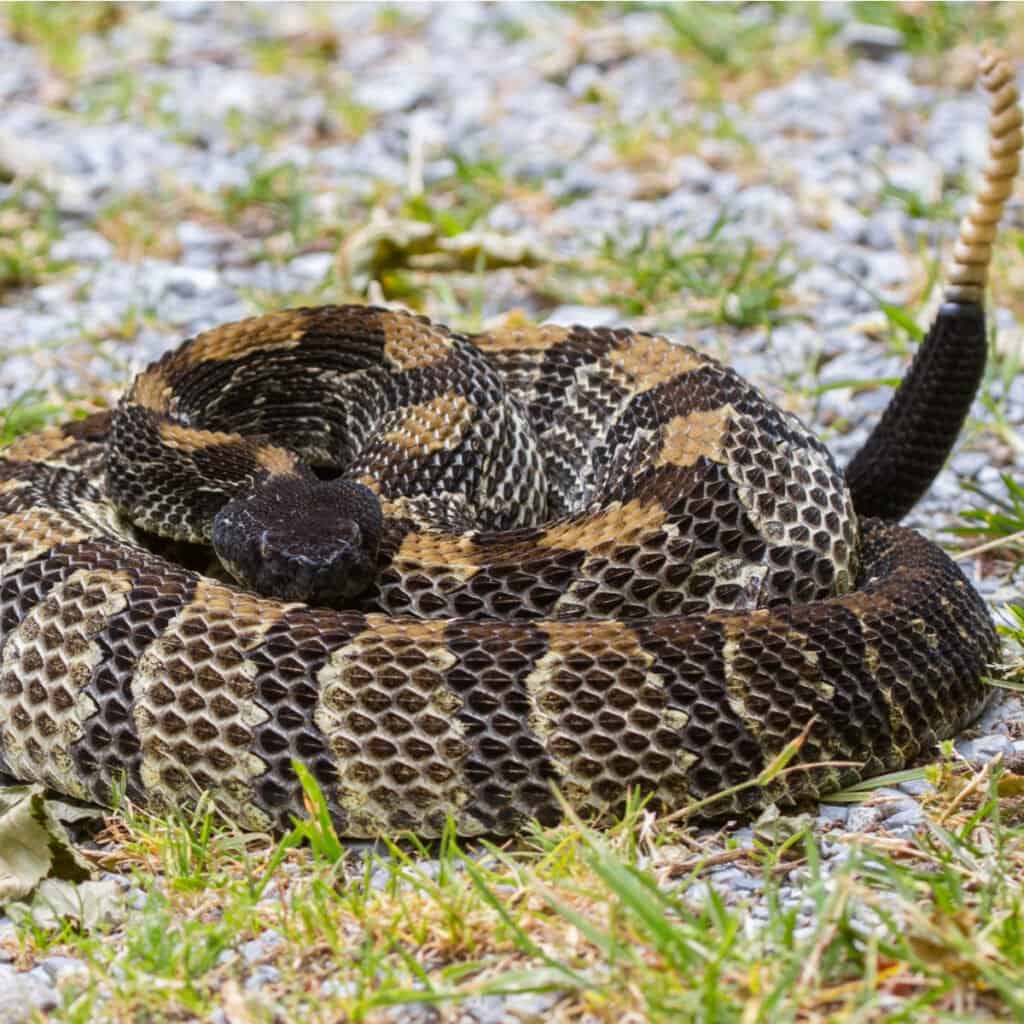
Timber rattlesnakes are one of the most venomous snakes in North America.
©Frode Jacobsen/Shutterstock.com
Also known as the canebrake rattlesnakes, timber rattlesnakes (Crotalus horridus) are large pit vipers which are between 36 and 60 inches long. They have a heavy, thick-set body which is usually yellowish or greyish brown with dark brown or black crossband markings. Their tails are black and end with a rattle typically held above the ground. Timber rattlesnakes prefer deciduous forests, damp fields, and swamps, but they hibernate in dens during the winter. They are one of the most venomous snakes in North America as they contain a large amount of venom. They have incredibly long fangs between 4 and 6 inches long. Despite being venomous, timber rattlesnakes are not particularly aggressive and generally prefer to flee rather than attack. Their diet consists mainly of small animals such as rodents, birds, and frogs.
Eastern Coral Snake
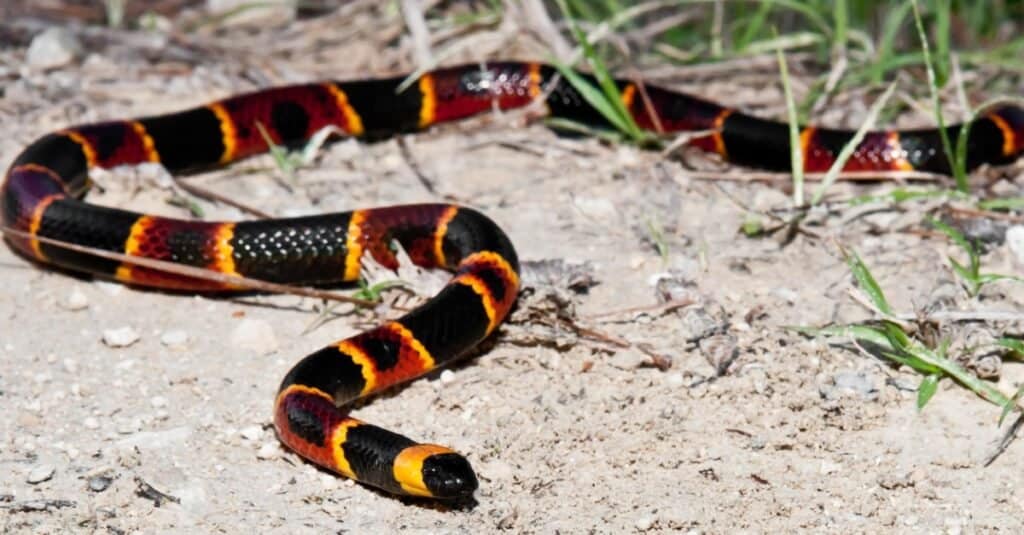
Eastern coral snakes are extremely dangerous as their venom is a powerful neurotoxin.
©iStock.com/JasonOndreicka
A brightly colored yet incredibly venomous snake in Alabama is the eastern coral snake (Micrurus fulvius). This slender snake has wide black and red bands separated by narrow yellow ones. A popular rhyme – red on yellow kill a fellow, red on black friend of Jack – is often used as a reminder to help distinguish them from the similar yet harmless kingsnake. However, it is not entirely reliable due to variations between individual snakes. Eastern coral snakes are 20 to 36 inches long and often live in pine and scrub oak forests but also in open regions without much vegetation. They are extremely dangerous as their venom is a powerful neurotoxin that causes respiratory failure and paralysis. Although they contain enough venom to kill five people, they cannot release it all in a single bite, nor are they particularly aggressive.
Eastern Diamondback Rattlesnake

Despite being large snakes, eastern diamondback rattlesnakes only bite when threatened.
©Chase D’animulls/Shutterstock.com
Another venomous pit viper is the eastern diamondback rattlesnake which is the largest species of rattlesnake in the world. Eastern diamondbacks (Crotalus adamanteus) are large, heavy snakes that typically reach between 33 and 72 inches long, although the largest recorded was an incredible 7.9 feet long. They have brownish bodies which are overlaid with large diamonds, hence their name. The diamonds have dark brown centers and cream-colored borders. Eastern diamondbacks typically inhabit pine forests, sandhills, and scrubland. Although they can strike at the frightening distance of 4 feet, they are thankfully not particularly aggressive and only bite when threatened or disturbed. They are ambush predators and mainly eat rabbits, rodents, and birds.
Pygmy Rattlesnake
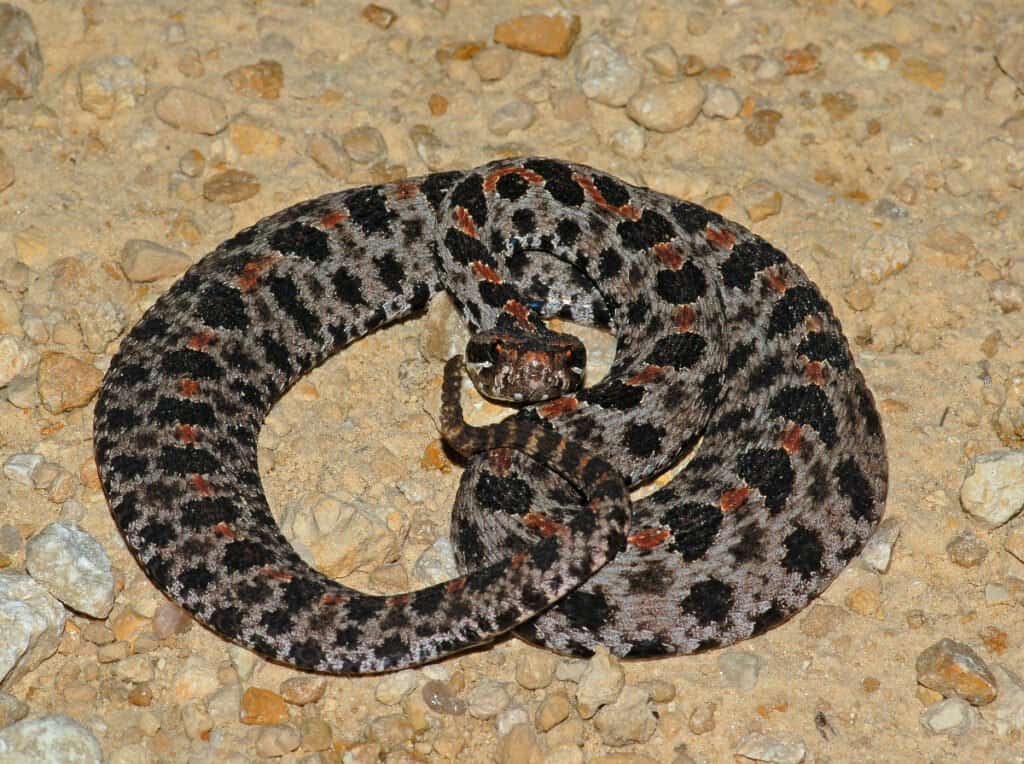
Pygmy rattlesnakes are only around 2 feet long and are rarely dangerous for healthy adults.
©Gerald A. DeBoer/Shutterstock.com
The smallest venomous snake in Alabama is the pygmy rattlesnake which is only 16 to 24 inches long. Pygmy rattlesnakes (Sistrurus miliarius) are gray with black blotches and a reddish stripe running down their back. Due to their small size, their rattle typically only sounds like a buzzing noise. They live in pine flatwoods, prairies, swamps, and near ponds and lakes. Pygmy rattlesnakes are ambush predators and prey on lizards, frogs, rodents, and other snakes. Although their venom is cytotoxic, they don’t produce much venom as they are so small. Therefore, they are very rarely dangerous to a healthy adult. However, they can still be dangerous to children and to the elderly. As they are small, they also have quite a few predators, which include hawks, owls, raccoons, and kingsnakes.
Cottonmouth
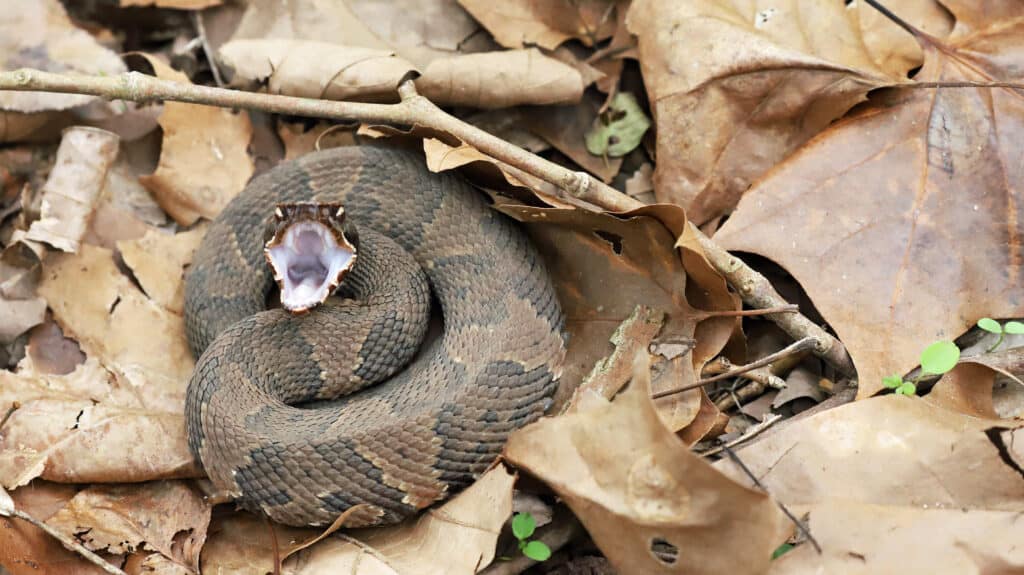
Cottonmouths are extremely dangerous as their venom destroys tissue.
©KF2017/Shutterstock.com
Also known as water moccasins, cottonmouths (Agkistrodon piscivorus) are semi-aquatic snakes found in and around slow-moving bodies of water. They particularly favor streams, lakes, and marshes but can be found up to one mile away from water too. They are large snakes with heavy bodies and can reach up to 72 inches long. Cottonmouths are typically black with dark brown crossband markings. When threatened, they tend to open their mouths, showing the white interior which earned them the name “cottonmouth.” They are opportunistic feeders and eat a wide range of insects, fish, frogs, lizards, birds, and other snakes (even fellow cottonmouths). Cottonmouths are incredibly venomous, and their venom contains cytotoxin, which destroys tissue. Although bites are not often fatal, the tissue is often damaged, which can lead to amputation in the most serious cases and extensive scarring in most others.
Copperhead
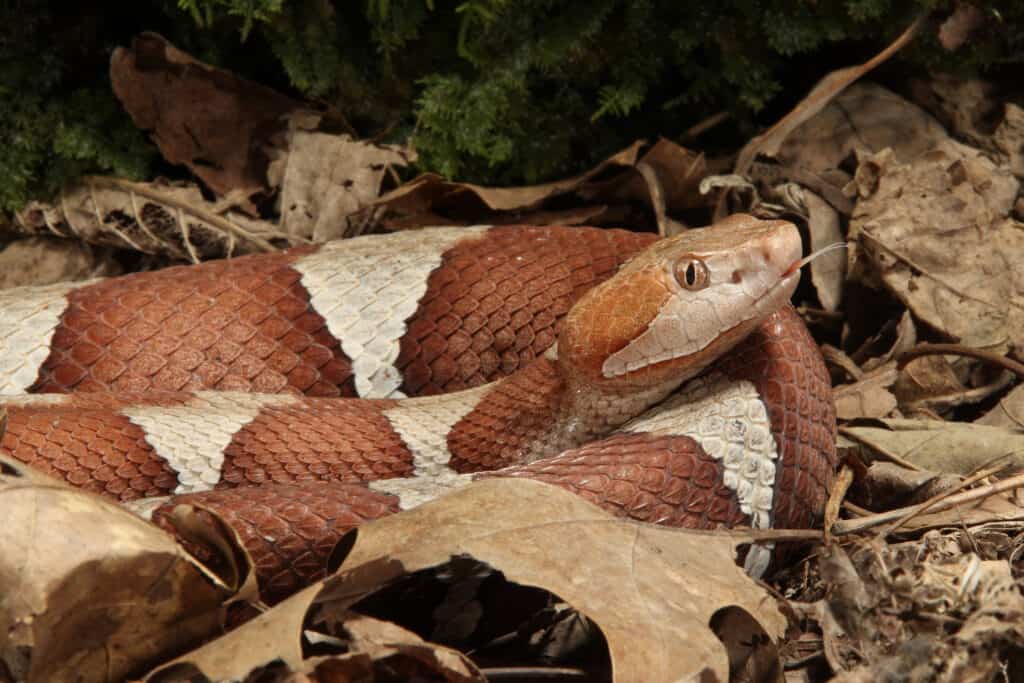
Copperheads only contain weak venom and usually employ a warning bite before striking.
©Dennis W Donohue/Shutterstock.com
The final venomous snake in Alabama is the copperhead (Agkistrodon contortrix) which reaches approximately 3 feet long. Copperheads are pale tan and covered with light brown or sometimes gray crossbands. The pattern of crossbands along the back is usually a distinctive hourglass shape, while the markings on their sides have light centers. Copperheads typically live in deciduous forests and mixed woodlands where rocks and piles of logs and leaves are preferred as shelters. Although venomous, copperheads tend to freeze rather than flee when disturbed. In fact, this is when most bites occur as they are unknowingly stood on. Luckily, they have some of the weakest venom of all the pit vipers and tend to give a “warning bite” first, which injects little to no venom.
The photo featured at the top of this post is © Joe McDonald/Shutterstock.com
Discover the "Monster" Snake 5X Bigger than an Anaconda
Every day A-Z Animals sends out some of the most incredible facts in the world from our free newsletter. Want to discover the 10 most beautiful snakes in the world, a "snake island" where you're never more than 3 feet from danger, or a "monster" snake 5X larger than an anaconda? Then sign up right now and you'll start receiving our daily newsletter absolutely free.
Thank you for reading! Have some feedback for us? Contact the AZ Animals editorial team.






